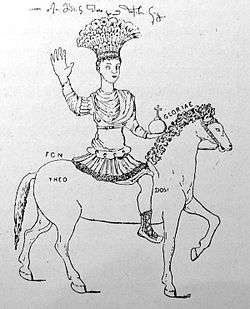Toupha

The toupha (Greek: τοῦφα / toúpha or τουφίον / touphíon) is a plumage of the hair or bristles of exotic animals, used to decorate horsemen's helmets and emperors' crowns.
One of the most famous touphas is that which surmounted the crown or helmet of the equestrian statue of Justinian I on the column raised by that emperor in the Augustaion square in Constantinople. It is known from a drawing of it made in the 15th century. Particularly imposing in size, it fell from the statue in the 9th century and was put back on by some dangerous acrobatics – a rope was stretched between the roof of Hagia Sophia and the summit of the column by means of an arrow along which someone could tightrope-walk to the statue. The emperor Theophilus rewarded the tightrope-walker with 100 gold nomismata for this exploit.
In colloquial language, toupha or typha came to mean a "tiara", and the 12th-century historian, Joannes Zonaras, even records that a verb, typhoomai ("to be filled with extreme arrogance"), was derived from it.
Bibliography
- Toupha, vol. 3, page 2100, of Alexander Kazhdan (ed.), Oxford Dictionary of Byzantium, 3 vols., Oxford University Press, 1991 (ISBN 0195046528)
See also
-
 Media related to Toupha at Wikimedia Commons
Media related to Toupha at Wikimedia Commons - War bonnet